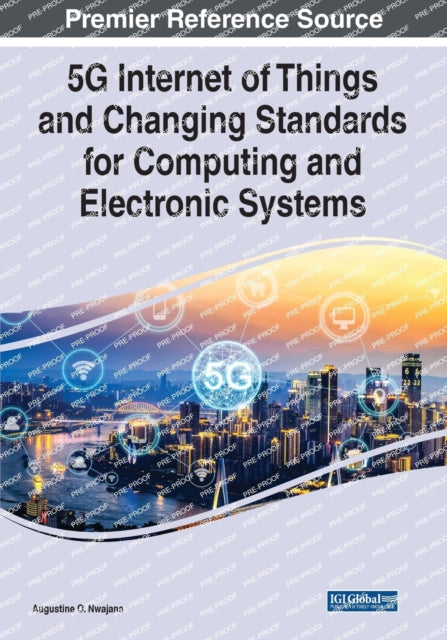Shulph Ink
5G Internet of Things and Changing Standards for Computing and Electronic Systems
5G Internet of Things and Changing Standards for Computing and Electronic Systems
YOU SAVE £1.88
- Condition: Brand new
- UK Delivery times: Usually arrives within 2 - 3 working days
- UK Shipping: Fee starts at £2.39. Subject to product weight & dimension
Bulk ordering. Want 15 or more copies? Get a personalised quote and bigger discounts. Learn more about bulk orders.
Couldn't load pickup availability
- More about 5G Internet of Things and Changing Standards for Computing and Electronic Systems
The Internet of Things (IoT) has transformed the way computing and electronic systems are interconnected, enabling faster and more efficient communication. 5G technology has further enhanced this connectivity, making it possible to create smart cities and implement IoT solutions. However, there are challenges to be addressed, such as security and privacy concerns, and a thorough review of the opportunities, difficulties, and benefits of 5G IoT is necessary for its successful utilization and implementation.
Format: Paperback / softback
Length: 325 pages
Publication date: 03 June 2022
Publisher: IGI Global
The advent of internet of things networks has revolutionized the way computing and electronic systems are interconnected. With the integration of 5G technology, computing and electronic devices, and systems can now seamlessly connect, rapidly transforming the world into a digital realm. While the concept of smart cities and the internet of things is here to stay, it is essential to conduct a comprehensive examination of the opportunities, challenges, and benefits associated with 5G internet of things to ensure its successful utilization and implementation.
The development of internet of things technology has brought about a significant shift in the way computing and electronic systems are interconnected. This transformation has led to the creation of smart cities, where various technologies are integrated to enhance the efficiency, sustainability, and livability of urban areas. One of the key technologies driving this transformation is 5G internet of things.
With the high speed and low latency of 5G networks, computing and electronic devices can communicate with each other seamlessly, enabling the creation of smart cities that are more efficient, sustainable, and connected. For example, smart traffic management systems can optimize traffic flow, reducing congestion and improving air quality. Smart buildings can use sensors and automation to optimize energy consumption, reduce waste, and improve the comfort of occupants. Smart healthcare systems can use wearable devices and remote monitoring to provide personalized healthcare services to patients.
However, the development of smart cities and the internet of things also presents several challenges. One of the biggest challenges is the security and privacy of data. With the increasing amount of data being generated by smart devices and systems, there is a risk of data breaches and unauthorized access. This requires robust security measures to be implemented to protect the privacy and security of data.
Another challenge is the scalability of 5G networks. As the number of smart devices and systems increases, the demand for bandwidth and capacity will also increase. This requires the development of new technologies and infrastructure to ensure that 5G networks can handle the growing demand.
Despite these challenges, the benefits of 5G internet of things are numerous. One of the biggest benefits is the increased efficiency of smart cities. By integrating various technologies, smart cities can reduce waste, optimize energy consumption, and improve the quality of life for citizens. For example, smart parking systems can help reduce traffic congestion, while smart waste management systems can reduce waste and improve recycling rates.
Another benefit of 5G internet of things is the improved connectivity of devices and systems. With the high speed and low latency of 5G networks, devices can connect to each other more easily and quickly, enabling the creation of new applications and services. For example, smart homes can be controlled remotely using a smartphone, while smart factories can use sensors and automation to improve productivity and reduce waste.
In conclusion, the development of internet of things networks and the integration of 5G technology has revolutionized the way computing and electronic systems are interconnected. Smart cities and the internet of things are here to stay, but they require a comprehensive examination of the opportunities, challenges, and benefits associated with 5G internet of things to ensure their successful utilization and implementation. By addressing the security and privacy concerns, developing scalable infrastructure, and leveraging the benefits of 5G internet of things, we can create a more efficient, sustainable, and connected world.
Dimension: 279 x 216 (mm)
ISBN-13: 9781668438565
This item can be found in:
UK and International shipping information
UK and International shipping information
UK Delivery and returns information:
- Delivery within 2 - 3 days when ordering in the UK.
- Shipping fee for UK customers from £2.39. Fully tracked shipping service available.
- Returns policy: Return within 30 days of receipt for full refund.
International deliveries:
Shulph Ink now ships to Australia, Belgium, Canada, France, Germany, Ireland, Italy, India, Luxembourg Saudi Arabia, Singapore, Spain, Netherlands, New Zealand, United Arab Emirates, United States of America.
- Delivery times: within 5 - 10 days for international orders.
- Shipping fee: charges vary for overseas orders. Only tracked services are available for most international orders. Some countries have untracked shipping options.
- Customs charges: If ordering to addresses outside the United Kingdom, you may or may not incur additional customs and duties fees during local delivery.


